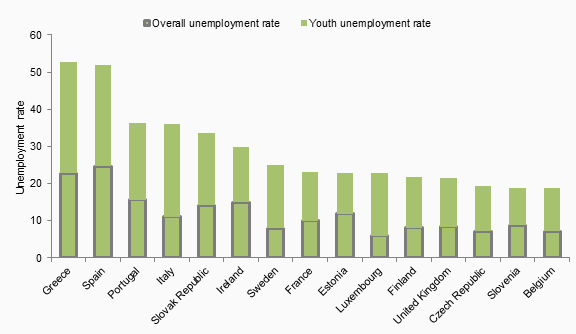The economic and social consequences of job losses since the onset of the global crisis have been enormous, as Ben Bernanke recently pointed out (Bernanke 2012). Unemployment rates have soared to an average of 11% in the Eurozone in mid-2012, and youth unemployment has reached alarming levels in many places, exceeding 50% in Greece and Spain.
Yet as bad as the crisis has been for jobs, in many advanced economies unemployment was already elevated before the crisis (Annunziata 2012; Gros 2012). This suggests that labour market challenges are not going to disappear even when the global economy recovers. Moreover, challenges differ across countries. Some do not have particularly high unemployment rates (e.g., Austria, Germany, and the Netherlands) but still face issues of low labour-force participation among certain population groups. In general, measures to catalyse short-term job growth will need to be complemented by well-targeted structural measures that get to the root of the specific employment issues faced by each country.
In many countries, the employment challenge is particularly daunting given the substantial fiscal adjustment already underway and the additional consolidation needed to bring public debt to more prudent and sustainable levels. But even in a world of difficult fiscal constraints, a recent IMF policy paper (IMF 2012) finds that well-designed tax and expenditure reforms can help catalyse employment over both the short term and the long term without busting the government budget. The scope for reallocating taxes and spending to enhance labour market outcomes differs across countries. Nevertheless some clear principles, as set out below, can help guide reforms.
Nature of the employment challenge
To understand how fiscal policy can help boost employment, let’s first look at some key labour-market weaknesses of advanced economies. For Europe and the US it turns out that the employment challenges are most pronounced among five specific groups:
- Those unemployed for more than a year. This group constitutes over half of total unemployment in several countries in central and southern Europe. It is also elevated in the US, where it has traditionally accounted for less than 10% of the total unemployed, but now accounts for about a third (Figure 1).
Figure 1. Advanced countries with the highest rate of long-term unemployment, Q1 2012*
Note: *Or latest data available. For the United States, data refer to 2011 (average) for the overall unemployment rate and 2010 (average) for the long-term unemployment rate. The full height of the bars indicates the total unemployment rate. The numbers inside the bars indicate the share of unemployment, which is long-term, and the height of the pink bars indicates the long-term unemployment rate.
Figure 2. Advanced countries with the highest rate of youth unemployment (15–24 years), Q1 2012
- Unemployed youth (those aged 15–24 looking for work). Youth unemployment stands at alarming levels not only in Greece and Spain, but also throughout much of Europe (Figure 2).
- Low-skilled workers (that is, workers with less than upper secondary education) typically face unemployment rates that are twice the rate of skilled workers. Unemployment rates of low-skilled workers are most elevated in Central Europe but also disproportionately high in Germany and the US.
- Older workers, aged 55-64. In Europe, labour-force participation rates among this group are generally 30 to 40 percentage points lower than the average.
- Women. Female participation rates are often much lower than male participation rates. For example, in Southern Europe they are 20 percentage points lower than rates for men.
Fiscal reform to boost employment
Several reforms to tax and expenditure policies could help boost employment and do so in a budget neutral way – for example, by shifting the tax burden. Some of the reforms involve improvements in design and will not necessary increase expenditures or reduce revenues. In the short term, these policies could stimulate job creation by boosting labour demand and improving the matching of workers with existing job vacancies. In the medium term, they could enhance incentives to participate in the labour force.
Finding jobs for youth
Tackling high youth unemployment calls for comprehensive policy packages that improve both training and job matching. In many countries there is scope to reallocate public spending toward “active labour market” programmes (ALMPs) that provide job-search assistance, targeted study-and-work programmes, and well-tailored wage subsidies (Card et al. 2010; Kluve 2010). Government benefit programmes should also be reformed to provide greater incentives for youth to work – for example, benefits for unemployed youth should be conditional on participation in ALMPs. Increased public spending in this area should be complemented by structural labour market reforms, including modifying rigid hiring and firing regulations and wage structures that shut young workers out of the labour market.
Reforming unemployment benefits
Unemployment and disability benefits have often been designed without sufficient attention to their potential effects on labour markets; in too many countries they provide a strong disincentive for job search (Krueger and Meyer 2002). To mitigate these disincentives, some countries have now strengthened activation conditions. Tougher job search requirements, combined with intensive monitoring and appropriate sanctions, have been successful in reducing the length of unemployment spells. Where the receipt of benefits has been made conditional on participation in ALMPs, exit rates out of unemployment have increased considerably. Reforms along those lines can sustain equity, while improving efficiency.
Jobs for low-skilled workers
The demand for low-skilled labour is relatively elastic and, therefore, reacts more strongly to policy measures. This suggests that targeted reductions in non-wage labour costs could help boost jobs. This could be achieved, for example, by establishing a threshold below which no or lower social contributions are levied. Hiring subsidies for low-skilled workers could also be effective (Kluve 2010). Such reductions in labour costs could be part of a revenue-neutral shift from labour to consumption taxes (or higher recurrent property taxes) as part of a 'fiscal devaluation'. Low-skilled workers can also be encouraged to work by providing tax credits that increase their take-home pay. Such in-work tax credits have been adopted by several advanced countries and evaluation studies point to encouraging results on employment (Immervoll and Pearson 2009). More progressive tax schedules could be considered as a revenue-neutral reform to reduce tax wedges for low-skilled workers.
Keeping the elderly in work
Older workers could be encouraged to work longer if their future pension benefits were adjusted fully for extra years of contributions, eliminating financial incentives to retire early. As older workers are found to be more sensitive to financial incentives than younger workers (French and Jones 2010), age-specific reductions in labour tax rates for older workers can boost incentives for them to remain in the labour force.
Making it easier to work while raising children
The labour supply of women is more responsive to taxes than that of men (Meghir and Phillips 2010). Hence, a revenue-neutral shift of the tax burden from women to men would, on net, boost labour supply. Where legal constraints prevent a gender distinction in the tax code, special tax relief could be targeted to single parents or to secondary-earners in couples. Another way to reduce the tax burden for secondary earners is by replacing family taxation with individual taxation. Family taxation (in place, for example, in France, Portugal and the US) results in high effective tax rates for secondary earners, especially when rates rise rapidly with family income. Child care subsidies or special tax relief for working mothers can also be effective in stimulating labour supply.
The urgency of reform
Timing is very important. Given weak economic conditions in many countries, the immediate priority should be to increase labour demand, and facilitate matching of job seekers and job vacancies. But countries should also move forward on measures to boost labour supply, as in most cases they will take some time to yield results. It is essential for countries to begin now on structural reforms to lay the foundation for more dynamic job growth over both the short and medium term. And the design of these reforms matters very much for employment outcomes.
References
Annunziata, M (2012), “Wasted Youth”, VoxEU.org, 14 May.
Bernanke, B (2012), Speech at the Federal Reserve Bank of Kansas City Economic Symposium, Jackson Hole, Wyoming, 31 August.
Card, D, J Kluve, and A Weber (2010), “Active Labour Market Policy Evaluations: A Meta-Analysis”, The Economic Journal, 120(November):452-477.
French, E and J Jones (2011), “Public Pensions and Labor Supply Over the Life Cycle”, International Tax and Public Finance, 1-20.
Gros, D (2012), “Europe’s Recurrent Employment Problems”, CEPS Policy Brief, 22 May.
IMF (2012), “Fiscal Policy and Employment in Advanced and Emerging Economies”, IMF Policy Paper, 15 June.
Immervoll, H, and M Pearson (2009), “A Good Time for Making Work Pay? Taking Stock of In-Work Benefits and Related Measures across the OECD”, IZA Policy Paper No. 3 (Bonn: Institute for the Study of Labor).
Kluve, J (2010), “The Effectiveness of European Active Labor Market Programs”, Labour Economics, 17:904-918.
Krueger, AB, and BD Meyer (2002), “Labor Supply Effects of Social Insurance”, in AJ Auerbach and M Feldstein (eds.), Handbook of Public Economics, 4.
Meghir C, and D Phillips (2010), “Labour Supply and Taxes”, in J Mirrlees, S Adam, T Besley, R Blundell, S Bond, R Chote, M Gammie, P Johnson, G Miles, and J Poterba (eds.), Dimensions of Tax Design (The Mirrlees Review, Institute for Fiscal Studies).







